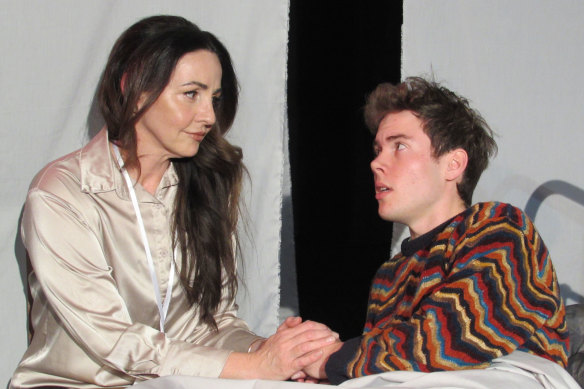A timeless froth of lust, sex and adultery: Is this the perfect musical?

Save articles for later
Add articles to your saved list and come back to them any time.
A LITTLE NIGHT MUSIC
Hayes Theatre, October 18
Until November 11
Reviewed by JOHN SHAND
★★★★
Is A Little Night Music the most timeless musical ever penned? Taking their cue from the Ingmar Bergman film Smiles of a Summer Night, about couples being naughty in 1900 Sweden, its creators, Stephen Sondheim and Hugh Wheeler, looked at hypocrisy with forgiving amusement; as an inevitability. Then they whipped into a froth the key ingredients of flirtation, lust, sex, marriage and adultery. Sin, you see, can be so very civilised.
Although this 1973 musical is often found in opera houses, director Dean Bryant’s Hayes Theatre production proves that, at heart, it’s a chamber work that, like finely engraved silver, prefers being rendered in miniature to being grandiose.
A Little Night Music: No other musical comes so close to being perfect on its own terms.Credit:
One could argue that Sondheim’s Sunday in the Park with George, say, surpasses Night Music as a work of art, but no other musical comes so close to being perfect on its own terms. Therein lies part of the timelessness, alongside the eternal nature of the foibles depicted, the effervescent wit of Wheeler’s book and Sondheim’s lyrics, the rich characterisations and the music’s ageless elegance: a compendium of styles in 3/4 time.
Above all, it’s a musical for actors, and Bryant has ensured no one in his cast muddies the taut, knotty interrelationships. His particular coup was landing Nancye Hayes – she for whom the theatre’s named – to play the wheelchair-bound grandmother Madame Armfeldt for the third time in her glittering career. Her performance is a masterclass in trusting the words and playing them with a restraint more usually found in big-screen close-ups.
More than anyone on the stage, she finesses her pauses to the microsecond, notably in her centrepiece, Liaisons. About the supposedly more sophisticated sensual delights that existed in her youth, it mixes world-weariness, wisdom, truth, fantasy and revisionist history, and includes the lines, “Take my daughter, I taught her, I tried my best to point the way. I even named her Desiree.”
Desiree, an actor, is the protagonist who reignites an old flame, while already having an affair with a volatile cavalry officer whose favourite sport is duelling. Blazey Best joins the noble roster of women (from Glynis Johns to Judi Dench) to play the role and makes it her own. Singing, “Isn’t it rich?“, the opening line of Send in the Clowns, has become as tough for an actor as saying “To be or not to be”, but Best shrugs aside all the baggage, and simple lets it live in all its raw candour and emotional complexity.
Leon Ford splendidly plays Frederik, the slightly wet, slightly pompous lawyer whom Desiree can’t relinquish, even if some of his sung pauses would benefit from Hayes’ microsecond instincts. Joshua Robson just manages to contain his performance as the duelling Carl-Magnus to the scale of the Hayes stage, and is an ideal foil for Ford in sparking much of the humour.
Melanie Bird excels as Frederik’s overwrought wife (who’s a virgin 11 months into their marriage), Anne, as does Erin Clare as Carl-Magnus’s infinitely more worldly and cynical spouse, who gives us that exquisite encapsulation of the human condition: Every Day a Little Death. Jeremi Campese, Kiana Daniele and Pamelia Papacosta round out the fine team of principals.
The stripped-down orchestration and Jeremy Allen’s simple set are in harmony with Bryant’s conception. The jarring element is the sound. The show should be restrained vocally and graceful musically. Instead, the sound was uneven, often too loud and sometimes rather tinny. With this rectified, the otherwise outstanding production would crown a bumper year for Sondheim in Sydney.
DMA’s
Enmore Theatre, October 14
Reviewed by MICHAEL BAILEY
★★★★
“The DMA’s? Is that an awards night or something?” asked my acquaintance, after I’d shared my choice of Saturday evening entertainment.
The DMA’s in Sydney: They know they are on to a winning formulaCredit: Mushroom Creative House
Clearly, Sydney’s most popular rock band of the moment, still has some work to do before filling stadiums. But the Newtown trio’s songs are already there, as this euphoric and exhilarating show proved repeatedly.
All the ingredients of DMA’s appeal were in the opening salvo to this sold-out theatre – the title track of March’s fourth album, How Many Dreams?
Washes of retro synthesiser swirled, begging for resolution as the band walked on and plugged in. Lifting his acoustic guitar up to his shoulder, Johnny Took introduced a rhythmic bounce for eight bars.
Then lead guitarist Matt Mason peeled off a riff as sharp as the brim of his baseball cap, cueing the hired hands on drums, bass and second rhythm guitar to deliver that resolution in a major-key manner that was obvious, yet an utterly joyous synthesis of dance and rock.
As the moshpit swayed and pogoed simultaneously, arguably the key ingredient in DMA’s success, particularly in its last two records going top 5 in the UK, was unleashed in the form of Tommy O’Dell’s vocal.
Comparing DMA’s to The Stone Roses and Oasis is as lazy as music criticism gets, and while O’Dell sounds nothing like Ian Brown or Liam Gallagher, the connection tonight was clear. All three have limited vocal ranges, and have rarely sung lyrics with any literal meaning. Yet they make you feel things when they sing.
For instance, the words “how many dreams to find out what you have lost?” are nonsense on paper. But somehow, when O’Dell’s pure and urgent voice sang them tonight, they rode the music and became an affirmation, to which many of us could only punch the air in agreement.
The DMA’s know they are on to a winning formula. So confident were they of their ability to keep lifting this audience, they played their biggest hit, Silver, and their Triple J-conquering cover, Cher’s Believe, in the first half of the setlist.
Yet the energy in the room stayed high, goosed along by Olympia’s nagging riff and killer chorus, the widescreen balladry of Hello Girlfriend and In The Air, and another credible house-rock hybrid in Something We Are Overcoming. O’Dell and Took frequently made “everybody up” gestures, but we were already there.
Then there was a peak even higher when Took introduced pop star Ruel, who helped DMA’s debut a catchy, soulful collaboration that felt destined for radio.
Airwaves and arenas are after all the natural homes for DMA’s music, as their indelible first single Delete, and then encore closers Lay Down and Everybody’s Saying Thursday’s The Weekend, proved rousingly tonight.
Household name status, however, might require DMA’s to reveal more of themselves in their songs. They soared so impressively tonight, one wondered what they’d make of things closer to ground.
DMA’s play a second show at Enmore Theatre on October 15.
Playing to savour rather than be dazzled by
Lilya Zilberstein in Recital
Presented by Sydney Symphony Orchestra
City Recital Hall, October 16
Reviewed by PETER MCCALLUM
★★★★
Lilya Zilberstein played the opening of Schubert’s first Moment Musicaux with elegant wistfulness, leaning on the peak note of the phrase just long enough to sound a note of regret. The sound she created at the piano in these gems was rounded and pearly – perfectly matched to the subtly tapered shape she brought to each idea.
Occasionally, and, in the intervening minor-key episodes of the second piece, memorably so, a mood of more intense expressiveness emerged. But in general the tone was one of gentle reverence, cultivating those moments in Schubert where he conjures the essence of what it is to be musical.
Lilya Zilberstein’s particular virtues reside in her poetic lyricism at the piano and her distinctive tone.Credit: Andrej Grilc
The second part of the first half continued the Schubert theme, albeit not quite as the composer imagined it. It consisted of four of the transcriptions of Schubert’s songs for solo piano that Franz Liszt arranged in 1838, initially to raise money for his fellow Hungarians devastated by the flooding Danube river.
Liszt evokes the combination of voice and piano on a single keyboard with great imagination and some embellishment and the arrangements proved hugely popular even though most of the pianists who constituted their market would have found their difficulties forbidding. Zilberstein’s particular virtues as a musician reside in her poetic lyricism at the piano and the distinctive tone of her overall musical conception.
She does not create moments of thrilling excitement and daring with the virtuosity but allows the lyrical idea to guide. The Wanderer, a song of 1816, had portentous drama, and Stänchen von Shakespeare preserved coyness and charm through Liszt’s virtuosic elaborations. In Gretchen am Spinnrade, Zilberstein kept the whirring “spinning wheel” motive subdued and nagging in the background.
In Rachmaninov’s Thirteen Preludes Opus 32 after interval, Zilberstein again established a poetic idea with each number and it was the pieces where melody dominated that made the greatest impression. In the Prelude No. V, the left hand provided a lapping accompaniment to a top line of transparent ornateness overwrought with ornate arabesque.
The Prelude VII maintained a whispering murmur in the inner parts against a piquantly pointed melody. For Prelude XII, the focus was a caressingly rich cello-like melody in the left hand with shimmering patterns of light from the right hand. The denser textures of pieces like Prelude XIII were turbulent without fierceness. This was playing to savour rather than be dazzled by.
A production built from and for love
The Disappearance
Chippen Street Theatre
October 12
Until October 22
Reviewed by CASSIE TONGUE
★★★
Independent theatre in Sydney faces impossible challenges: financial pressures, especially in a cost-of-living crisis; a scarcity of venues; and the struggle to engage audiences with more entertainment options than ever before. Independent artists stretch tiny budgets to make something out of nothing – every production is hard-won, built from love and sacrifice.
Rebecca Matthews as Dr Clemm with Gordon Vignelles as Roger.
Take The Disappearance, now at the Chippen Street Theatre (a 50-seat black box theatre and home of Sydney Eisteddfod). Based on both the Kin Platt 1968 novel The Boy Who Could Make Himself Disappear and its film adaptation, 1973’s Baxter!, this play is a labour of love. Les Solomon created it 1975 and produced it as a youth theatre project in 1990. This is its first full production, which Solomon directs.
The story is difficult and didactic, but deeply-felt: California-born Roger (Gordon Vignelles) hasn’t had it easy. His parents (Joe Clements and Kath Gordon) are abusive, often using Roger’s speech disorder as a target.
Things only get worse when Roger and his motherland in Sydney. He discovers new allies in speech therapist Dr Clemm (Rebecca L Matthews) and his neighbours, a sweet model (Talia Sigsworth) and her celebrity chef partner (Andrew Lindqvist), who take Roger under their wing. But as things at home worsen, Roger’s mental health deteriorates.
The production is rough-edged and the script strains under the weight of the plot. It feels dated – unsurprisingly, given the first draft was written nearly 50 years ago – and there’s a mismatch of tones and character work from the cast, who don’t always feel part of the same world.
But this is a play built from and for love; it so clearly believes in the power of bringing awareness to these issues of mental health and abuse. Vignelles, Sigsworth and Lindqvist find something tender and real in the safe space they make together for Roger, and when that sanctuary is later shattered, you may be surprised to feel you mourn its loss.
This is what independent theatre is for: telling stories artists believe in, making art because they must, and finding space for artists of all levels of abilities and experience to do what they love and hone their craft. As long as there are audiences and venues in which they can meet, this vital work will persist, and artists will continue to adapt, learn, and discover new depths. The arts sector can only benefit from this continued experiment to experience, play, and grow.
Most Viewed in Culture
From our partners
Source: Read Full Article



